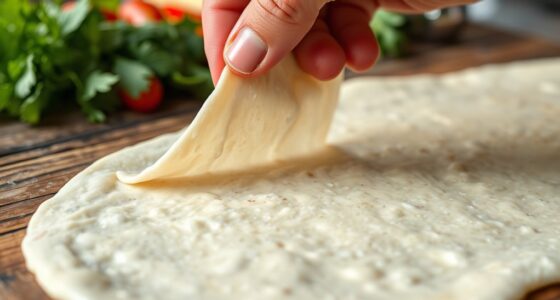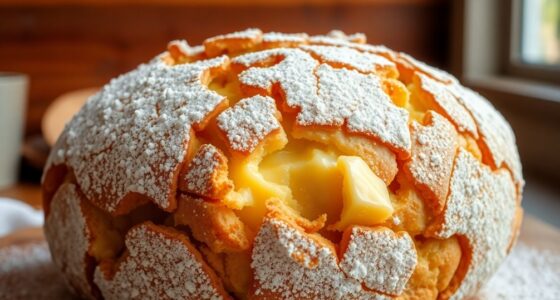To troubleshoot French macarons, focus on controlling oven temperature, drying shells thoroughly before baking, and folding batter carefully to avoid overmixing or under-mixing. Guarantee your batter flows like lava and the shells develop a dry skin before baking to prevent cracks. Proper equipment, environment, and resting times are key. If you keep these tips in mind, you’ll consistently improve your macarons, and more detailed solutions are just ahead to help you perfect your technique.
Key Takeaways
- Properly control oven temperature and drying time to prevent shell cracking and surface irregularities.
- Ensure batter is correctly whipped, folded, and rested for proper rise and feet formation.
- Achieve the right batter consistency (lava-like flow) through careful mixing and folding techniques.
- Prepare baking sheets with parchment or silicone mats to prevent sticking and facilitate easy release.
- Maintain a stable environment, avoid humidity, and use quality equipment for consistent results.
Troubleshooting Macaron Shell Cracking
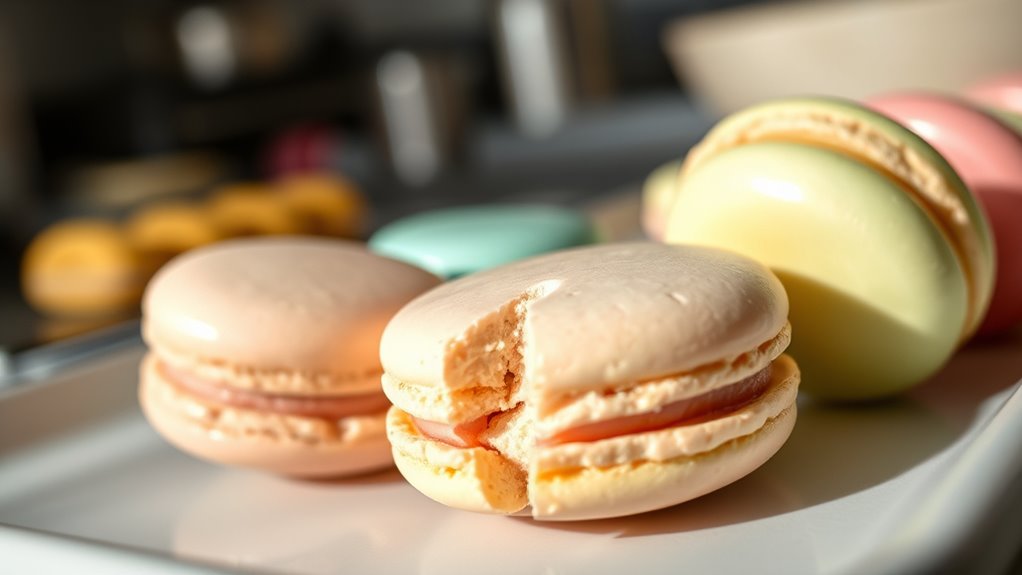
Cracking on macaron shells is a common issue that often results from improper oven temperature, overmixing, or insufficient drying time. When your oven runs too hot, the shells can puff up quickly and crack as they expand. Overmixing the batter can also weaken the structure, making shells prone to cracking during baking. Additionally, if you don’t let the shells dry enough before baking, moisture trapped inside causes steam to build up, leading to cracks. To prevent this, ensure your oven is calibrated correctly, mix the batter just until it flows smoothly without overworking it, and give your shells plenty of time to dry on the baking sheet. Proper preparation and attention to detail are key to achieving smooth, crack-free macaron shells. Being familiar with baking techniques can also help you troubleshoot and improve your results. Furthermore, understanding how industry transformations influence ingredient quality and baking equipment can give you an edge in refining your process. Maintaining consistent oven temperature and using high-quality ingredients can also significantly reduce the likelihood of cracks. Additionally, adopting proper baking practices can help ensure your macarons come out perfect every time.
Addressing Feet Formation Problems
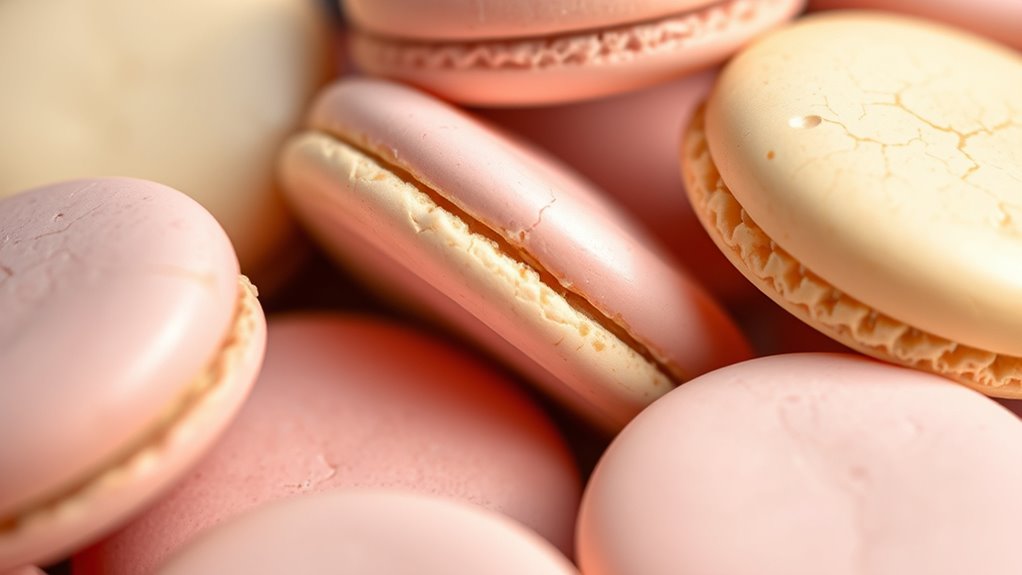
Are your macarons failing to develop the characteristic feet? This can be frustrating, but don’t give up. Feet form when the batter rises properly during baking, creating those beautiful ruffled edges. To improve, consider these common issues:
If your macarons lack feet, check your batter mixing, resting time, and oven temperature for perfect rise.
- Overmixing the batter, which deflates the meringue and prevents rising
- Under-whipping the meringue, resulting in weak structure
- Using low-quality or old almond meal that impairs adhesion
- Baking at the wrong temperature, hindering proper expansion
- Not letting the batter rest long enough before baking
Addressing these points can make a huge difference. Adjust your technique, ensure your ingredients are fresh, and give the batter enough resting time. With patience and practice, you’ll see those perfect feet start to form, elevating your macarons to perfection.
Achieving a Smooth, Glossy Shell
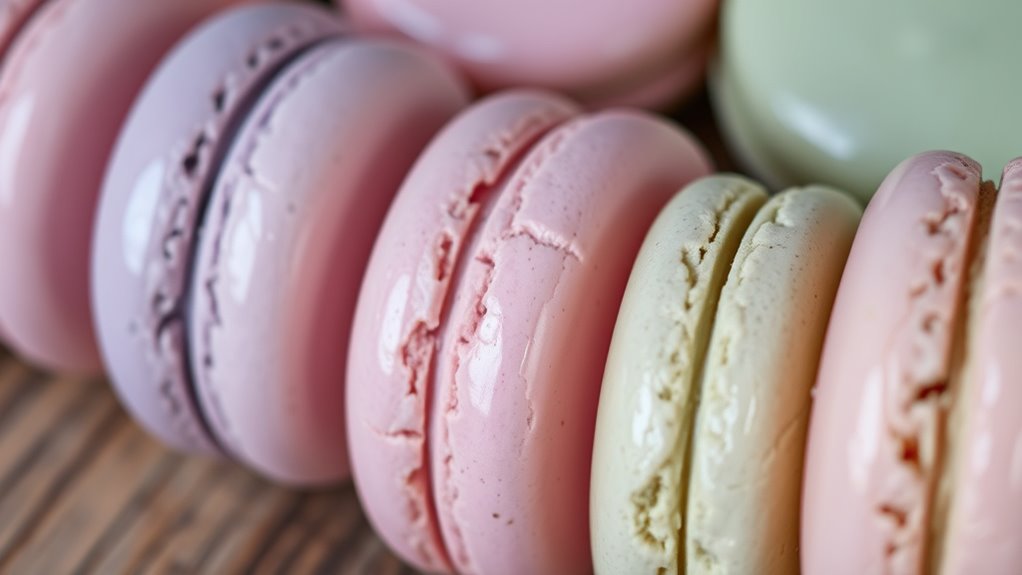
Once your macarons have developed the desired feet, the next step is to achieve a smooth, glossy shell that makes them visually stunning. To do this, guarantee your batter is properly folded, avoiding overmixing or undermixing, which can cause surface irregularities. After piping, gently tap the baking sheet to release air bubbles and help the surface settle. Let the macarons sit at room temperature until a thin skin forms; this usually takes 20-30 minutes. During this time, avoid touching the shells. When ready, the surface should be dry and slightly matte. Bake at the correct temperature, typically around 300°F (150°C), to encourage a shiny finish. Proper timing and temperature are key to developing that beautiful, glossy shell that’s characteristic of perfect macarons. Incorporating automation in monitoring baking conditions can help ensure consistent results.
Preventing Macarons From Sticking to the Baking Sheet
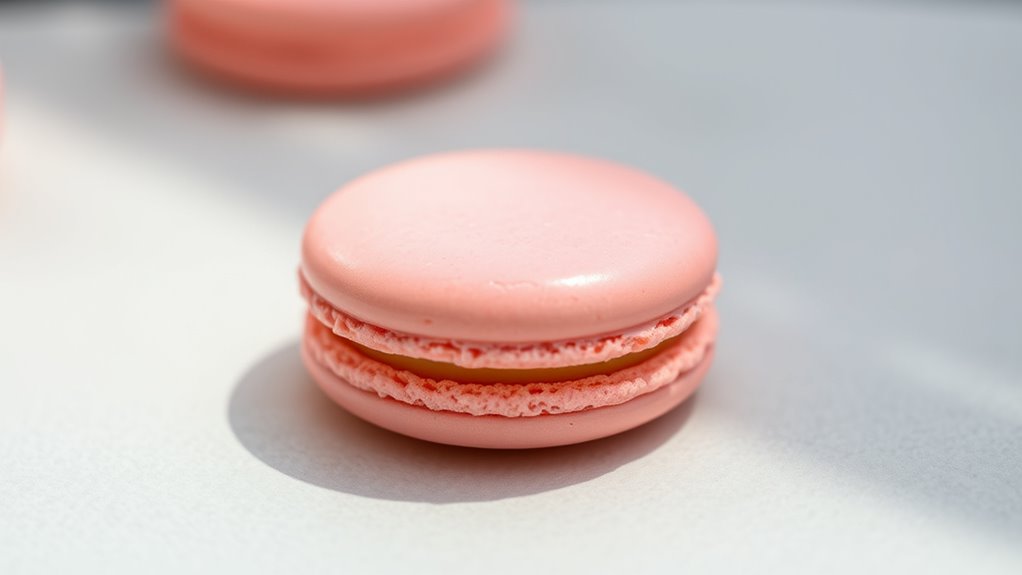
To prevent your macarons from sticking, start by choosing the right lining, like parchment paper or silicone mats. Make sure your baking sheet is properly prepared and clean to guarantee easy release. These simple steps can make a big difference in achieving perfect, intact macarons. Additionally, ensuring the surface has the appropriate surface reflectivity can help prevent sticking and improve overall results. Using a baking sheet with a non-porous, smooth finish can also help maintain consistent baking surface conditions, further reducing the risk of macarons sticking. Incorporating non-stick coatings designed for baking can provide an extra layer of protection and facilitate easy removal. Proper material selection of your baking sheet can also influence how easily the macarons release after baking.
Choosing Parchment or Silicone
Choosing the right baking surface is essential for preventing macarons from sticking. Your choice between parchment paper and silicone mats can make a big difference in your results. Parchment paper is reliable, easy to use, and offers a slight non-stick surface that works well for most bakers. Silicone mats provide a reusable, consistent surface that reduces waste and offers excellent release. Consider these factors:
- Feel confident knowing your macarons will release cleanly
- Save time with quicker, easier cleanup
- Reduce risk of tearing or breaking during removal
- Achieve even baking with a stable surface
- Trust in a proven method that elevates your baking game
Choosing the right surface guarantees your macarons come out perfect, with smooth shells and a professional finish. Sound vibrations are believed to enhance cellular regeneration and overall health, which can also influence the overall quality of your baking environment.
Proper Baking Sheet Preparation
How you prepare your baking sheet can make all the difference in preventing macarons from sticking. First, line it with parchment paper or a silicone baking mat—both options work well. If using parchment, ensure it’s smooth and free of wrinkles. Lightly spray the surface with a non-stick spray or brush it with a thin layer of neutral oil, then wipe off the excess. This creates a barrier that helps release the macarons easily. Avoid greasing the entire sheet heavily, as excess oil can cause the shells to become soggy. Let the lined sheet sit at room temperature for a few minutes before piping. Proper preparation guarantees the macarons won’t stick, and they’ll come off smoothly after baking. Additionally, using a noise-reducing baking sheet can help minimize vibrations that might affect the macaron’s structure during baking. Being aware of baking sheet materials can further improve your results. Incorporating natural materials, such as wooden or silicone mats, aligns with the principles of Waldorf toys and can enhance your baking experience by providing a more eco-friendly and effective surface.
Correcting Over-Mixed or Under-Mixed Batter
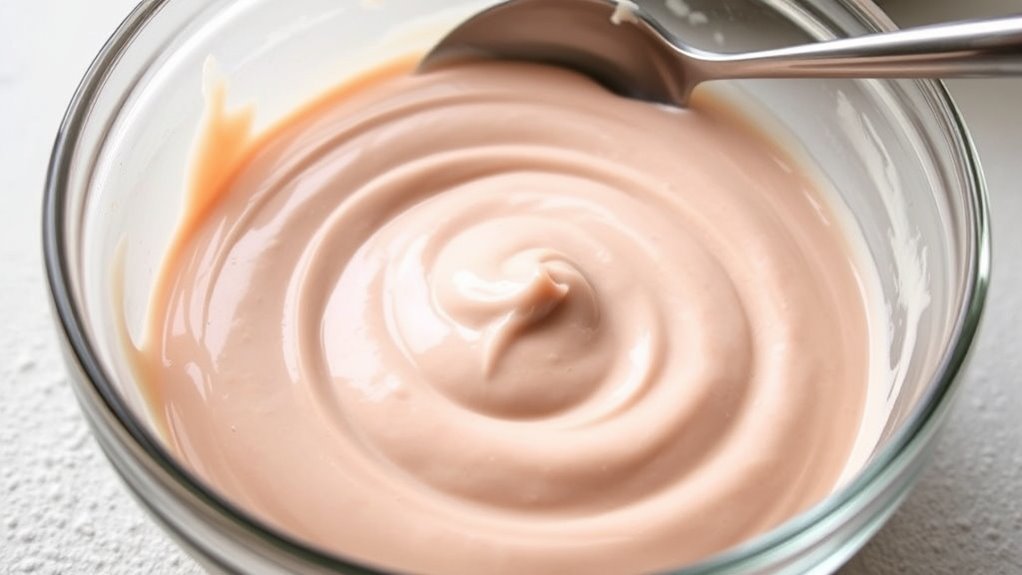
If your macaron batter is over-mixed, it becomes too runny and loses its ability to hold a smooth, glossy texture. You might notice the batter spreading too quickly or flattening when piped. To fix this, gently fold in a small amount of almond flour or powdered sugar until the batter reaches a lava-like consistency. Conversely, if the batter is under-mixed, it will be stiff and difficult to pipe smoothly. To correct this, fold more carefully but efficiently to loosen it. Remember, the key is to achieve the right flow without overworking. The right consistency makes all the difference, giving you the confidence to pipe perfect shells that rise beautifully. Incorporating proper exfoliation techniques can also help improve the overall quality of your baked goods by ensuring even mixing. Additionally, paying attention to mixing techniques can help prevent these issues from occurring in the first place. Practicing batter consistency and monitoring its texture is essential for achieving perfect macarons every time. For example, maintaining the correct batter flow can be achieved by adjusting folding techniques or resting the batter briefly before piping. Keep practicing, and soon you’ll master the ideal batter texture every time.
Managing Dry or Uneven Macaron Shells
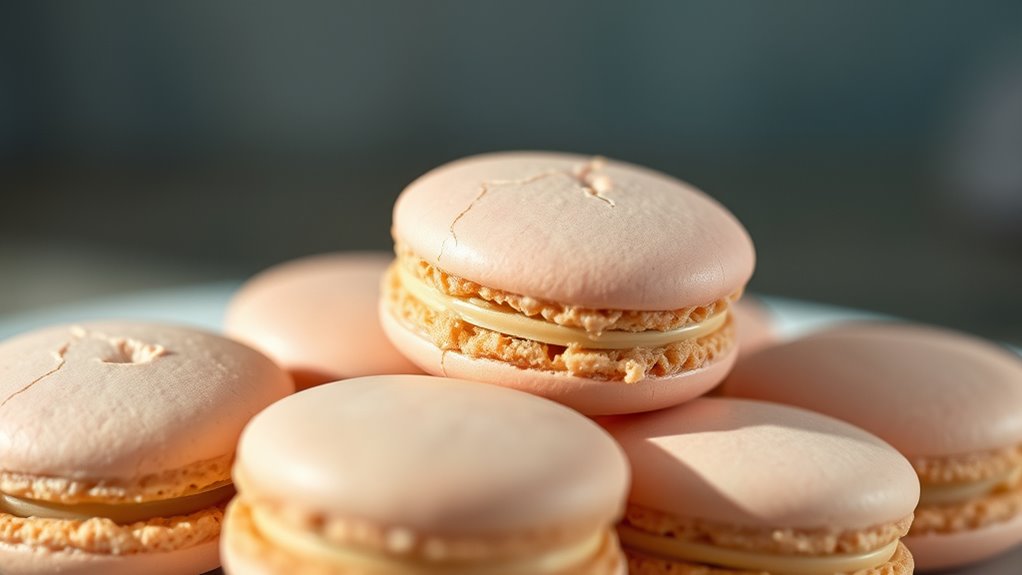
Have you noticed that some of your macaron shells turn out dry or uneven in texture? This often happens when the batter is over-mixed or the drying process was insufficient. To fix dry shells, verify your batter is folded just enough to flow smoothly but not so much that it loses structure. Properly drying your shells helps develop a thin skin, which prevents uneven surfaces. Before piping, let your shells sit at room temperature until they develop a slight crust—usually 20-30 minutes. If your shells turn out uneven, check your piping technique to keep the size consistent. Also, make sure your oven temperature is stable and not too hot, as uneven heat can cause shells to dry out unevenly or crack. Additionally, ensuring the meringue stability is maintained during mixing can prevent shells from drying out too quickly. Paying attention to workspace organization can also help you work more efficiently, reducing the risk of overmixing or rushing during the process. Incorporating equipment and tools designed for precise piping can further improve consistency. Being mindful of baking environment conditions, such as humidity and airflow, can further improve your macaron results. Moreover, understanding resources and tools can help you select the right equipment and ingredients to achieve more consistent shells.
Fixing Hollow or Sunken Macarons
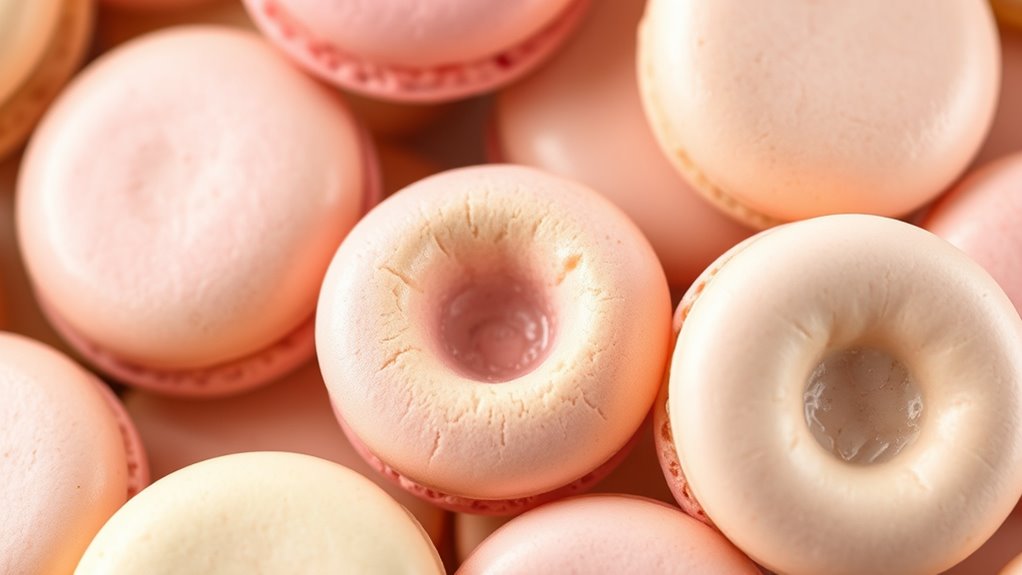
Hollow or sunken macarons can be frustrating, but addressing common issues in your process can help you achieve perfect shells. To prevent hollowness, ensure your batter is mixed just enough—overmixing traps air, causing bubbles. Proper oven temperature is vital; too hot, and shells rise too quickly, leaving gaps. Avoid opening the oven door during baking, which can cause sudden temperature drops. Make sure your meringue is glossy and stiff before folding, as weak meringue can lead to sinking. Finally, give your macarons enough resting time for a skin to form, helping them rise evenly. Additionally, understanding the importance of glycolic acid benefits can help manage stress and anxiety that might affect your baking process. Maintaining a consistent environment and proper technique is essential for successful macaron baking, ensuring your cookies turn out flawless every time. Being aware of pinball machine weights can also be useful if you’re setting up your baking space or moving equipment around.
Frequently Asked Questions
How Can I Store Macarons to Maintain Freshness and Texture?
To keep your macarons fresh and maintain their delicate texture, store them in an airtight container. Place a sheet of parchment or wax paper between layers to prevent sticking. Keep the container in a cool, dry place away from direct sunlight. For longer storage, refrigerate for up to a week or freeze for up to a month. Just allow frozen macarons to come to room temperature before serving.
What Tools Are Best for Piping Perfect Macaron Shells?
To pipe perfect macaron shells, you’ll want the right tools. Use a high-quality piping bag with a medium round tip, like a 12 or 14 gauge, for precise shapes. A silicone spatula helps fill the bag smoothly without air bubbles. Consider a template or stencil to guide your piping for uniform size. Practice controlling pressure and speed to achieve smooth, even shells that bake beautifully.
How Do Humidity Levels Affect Macaron Baking Results?
Ever wonder why your macarons turn out different every time? Humidity plays a big role in baking success. When the air is too humid, the shells might not dry properly, causing cracks or a sticky texture. On dry days, they may form a delicate skin faster, leading to perfect feet. Keep an eye on the weather, and adjust your drying time or oven settings accordingly to get consistent, beautiful macarons.
Can I Freeze Macarons Without Compromising Quality?
You can freeze macarons without sacrificing quality if you do it properly. Place them in an airtight container, separating layers with parchment paper to prevent sticking. Wrap the container tightly and freeze for up to a month. When ready to enjoy, let them thaw at room temperature for about 15-20 minutes. This way, you preserve their delicate texture and flavor, ensuring they taste fresh when served.
What Are Common Mistakes to Avoid in Macaron Baking?
Think of baking macarons as steering a delicate dance. You’ll want to avoid common missteps like overmixing your batter, which can cause cracks, or underwhipping, leading to flat shells. Skipping the aging process of egg whites or using improper oven temperatures can also throw you off beat. Pay close attention to ingredient ratios and gentle folding. Stay patient and precise, and you’ll master the rhythm of perfect macarons.
Conclusion
With patience and practice, you’ll master perfect macarons. Remember, every mistake is a stepping stone to success. Don’t throw in the towel if things don’t go perfectly the first time—every cloud has a silver lining. Keep troubleshooting, adjusting, and learning from each batch. Before you know it, you’ll be turning out flawless macarons that impress every time. Stick with it, and soon you’ll be the master of your own sweet success!


